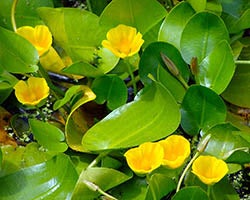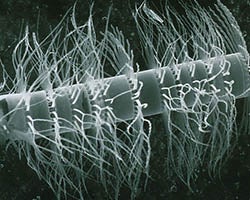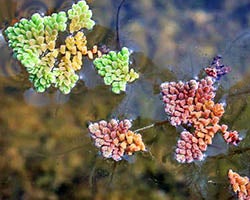
When you think about photosynthesis, or organisms that can take energy from the sun and make it into food, you probably think about plants. Plants are the most commonly recognized producers. However, phytoplankton and bacteria can also be producers.
Producers are organisms that produce their own energy by using sunlight to break down carbon dioxide (one of the molecules in air). This process is called photosynthesis. During photosynthesis, producers use the energy from sunlight to separate carbon dioxide into carbon molecules and oxygen molecules. The producers can then use the carbon to grow, while the oxygen molecules are breathed out by the producers and can then be breathed in by animals, like humans.
The Tiny Ones
The tiniest freshwater producers are phytoplankton and algae. Phytoplankton and algae can be attached to an object or rock in the water, or they may simply float around.

Individual phytoplankton and algae are too small to be seen by the naked eye of humans. However, phytoplankton and algae are often grouped together in large communities and we can see these large communities as discolored or mossy looking regions of water. And even though each of these individual producers is very small, together, they are responsible for the majority of photosynthesis in freshwater systems. Phytoplankton and algae also serve as the lowest level on the food chain, providing food for other freshwater animals.
But what exactly is phytoplankton or algae? The term algae stands for many different types of producers that include bacteria, green algae (an evolutionary ancestor of plants), and diatoms (single-celled organisms that can either live individually or as part of a colony). Some diatoms are free floating (like phytoplankton), where they move through the water with very little control over their movements, but some male diatoms also have a flagellum, a whip-like tail, which they can use to move around. Additionally, many unattached planktonic algae also have a flagellum to help move around water.

Human activities, such as pollution, can result in a plankton bloom. These plankton blooms occur when cyanobacteria or blue-green algae grow at exponential rates, causing all the oxygen to be sucked from the water. This results in a "dead zone" where animals cannot live.
Sinkers
Many lakes and rivers have plants that are attached to the ground beneath the water and grow to either near or past the surface of the water.

In temperate marshes, lakes, and stream edges you can see attached plants such as reeds, watercress, and bulrushes.
In tropical marshes, rivers, and lake edges you can see different attached plants such as reeds and water lilies.
Estuaries are where fresh and salt water meet. These habitats can contain various grasses such as eel grass and widgeon grass.
In deep regions of lakes, you can find willow moss and various kinds of worts, such as quillwort and stonewort. Ponds and slower streams can support water lilies, pond weeds, coontails, and milfoil.
Floaters

Additionally, some plants are not actually attached to the ground at all. Instead they just float on the surface of water and have roots that dangle freely in the open water.
Decomposers – Taking Out the Waste
Microbes and fungi all help break down the dead plant and animal life that falls to the floor of rivers and lakes. By eating dead plants and animals, decomposers are breaking this dead matter back down into its most basic nutrients. Phytoplankton can then take in these nutrients and use them to grow and restart the circle of life.
Bacteria are tiny single-celled organisms that can exist in very large numbers in the soil, and to a lesser amount in the water, of freshwater systems. Bacteria are one of the main types of organisms responsible for breaking down dead matter in freshwater systems. However, if bacteria reproduce to higher than normal levels, it can result in a health hazard for both humans and animals that are exposed to the water.
Fungi also take part in breaking down dead matter. You can find various types of fungi such as water molds, mildews, and yeast in freshwater systems. And despite fungus’s appearance and people’s initial beliefs about fungi, fungi are now actually thought to be more closely related to animals than plants.
Additional images via Wikimedia Commons. Spirogyra by Bob Blaylock.
Read more about: Falling into Freshwater
Bibliographic details:
- Article: Producers and Decomposers of Freshwater
- Author(s): Dr. Biology
- Publisher: Arizona State University School of Life Sciences Ask A Biologist
- Site name: ASU - Ask A Biologist
- Date published:
- Date accessed:
- Link: https://askabiologist.asu.edu/producers-and-decomposers-freshwater
APA Style
Dr. Biology. (). Producers and Decomposers of Freshwater. ASU - Ask A Biologist. Retrieved from https://askabiologist.asu.edu/producers-and-decomposers-freshwater
Chicago Manual of Style
Dr. Biology. "Producers and Decomposers of Freshwater". ASU - Ask A Biologist. . https://askabiologist.asu.edu/producers-and-decomposers-freshwater
Dr. Biology. "Producers and Decomposers of Freshwater". ASU - Ask A Biologist. . ASU - Ask A Biologist, Web. https://askabiologist.asu.edu/producers-and-decomposers-freshwater
MLA 2017 Style

Green algae is also found in freshwater, where it performs photosynthesis.
Be Part of
Ask A Biologist
By volunteering, or simply sending us feedback on the site. Scientists, teachers, writers, illustrators, and translators are all important to the program. If you are interested in helping with the website we have a Volunteers page to get the process started.

